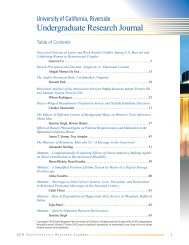UC Riverside Undergraduate Research Journal
UC Riverside Undergraduate Research Journal
UC Riverside Undergraduate Research Journal
You also want an ePaper? Increase the reach of your titles
YUMPU automatically turns print PDFs into web optimized ePapers that Google loves.
Computational Prediction of Association Free Energies for the C3d-CR2 Complex and Comparison to Experimental Data<br />
Alexander S. Cheung<br />
Association in vacuum is described simply by Coulomb’s<br />
law, using the same dielectric coefficient for protein and<br />
solvent in the absence of ions (ε p<br />
= ε s<br />
= 2; κ = 0). Association<br />
in solution is described by the Poisson-Boltzmann equation<br />
with different dielectric coefficients for the protein and<br />
solvent in the presence of ions (ε p<br />
= 2; ε s<br />
= 78.5; κ ≠ 0).<br />
Solvation describes the transfer of the protein or protein<br />
complex from vacuum into solution.<br />
The electrostatic free energy of association is given by<br />
(5)<br />
where<br />
, with tip and base referring to<br />
the direction of the arrows in the thermodynamic cycle. We<br />
solve Eq. (5) for<br />
Table 1 lists the mutants (also shown graphically<br />
in Fig. 1), solvation free energy differences (Eq. 5),<br />
calculated electrostatic free energies of association in<br />
solution without solvation effects (Eq. 6), experimental<br />
binding ability data for C3d mutants [9] and CR2<br />
mutants [6], previously published calculated ionization<br />
free energy differences [5], and calculated distances<br />
of each mutated amino acid from the association site<br />
contact residues. The distances were calculated using<br />
the C3d-CR2 structure (Fig. 1) and Glu116 (in C3d) and<br />
Arg390 (in CR2) as the association site contact residues.<br />
Distances were measured between the central atoms of<br />
the ionization sites: C γ for Asp, C δ for Glu, N ζ for Lys, C ζ<br />
and for Arg. Experimental binding abilities are relative<br />
to the parent proteins [6,9]. The key for the experimental<br />
binding abilities is as follows: +++++, 2-fold increase;<br />
(6)<br />
which represents the solvation free energy difference<br />
upon C3d-CR2 association between solution and vacuum<br />
environments.<br />
In order to perform this calculation, we must<br />
know , , and , which are<br />
determined by calculating the 6 electrostatic free energies<br />
for C3d, CR2, and C3d-CR2 in vacuum and in solution and<br />
by taking their differences according to the thermodynamic<br />
cycle of Fig. 3 and Eqs. (5) and (6). As can be seen in Eq.<br />
(6) the solvation free energy difference, ΔΔG solvation ,<br />
is equal to the electrostatic free energy of association in<br />
solution,<br />
minus the Coulombic free energy<br />
of association in vacuum, (also seen in the<br />
thermodynamic cycle of Fig. 3).<br />
To assess the effect of solvation in association, we<br />
also calculated the electrostatic free energy of association<br />
in solution alone (bottom horizontal step only in Fig. 3)<br />
according to<br />
(7)<br />
The values of and as<br />
described by Eqs. (6) and (7) were calculated 24 times:<br />
once for the parent proteins and once for each of the 23<br />
sets of mutant protein.<br />
Figure 4. (A) ΔΔG solvation (calculated using the complete<br />
thermodynamic cycle of Fig. 3) versus relative association ability<br />
with a linear fit drawn in red. (B)<br />
(calculated using<br />
the bottom horizontal reaction only of the thermodynamic cycle<br />
of Fig. 3) versus relative association ability.<br />
18 <strong>UC</strong>R Un d e r g r a d u a t e Re s e a r c h Jo u r n a l














